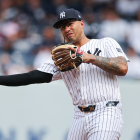The Arizona Diamondbacks (82-80) were eliminated from the 2018 postseason after a stunning September collapse where they lost 19 of their last 26 games. The team was officially out on Sept. 23, with six games left on the schedule, after they got swept by the Colorado Rockies at Chase Field in Phoenix.
The Diamondbacks did have an extremely difficult September schedule that saw them play 15 of 21 games against first-place teams. Arizona tied a major-league record with 14 straight games against first-place teams from Sept. 6-19, matching the 1993 Orioles and 1996 Tigers, per the Elias Sports Bureau.
And while Arizona is still reeling from its awful stretch of baseball when it mattered most, an issue even bigger than the fact that it couldn't hold onto a playoff spot is the fact that the team is just a few months away from watching some of its biggest names enter the free-agent market.
Patrick Corbin, A.J. Pollock, Eduardo Escobar will all be free agents this offseason while Paul Goldschmidt is just a little over a year from also becoming a free agent.
Their $159.47 million total salary jumped from 2016, which was $116.50 million. Arizona's big midseason acquisitions included Clay Buchholz, Jon Jay, Escobar, Brad Ziegler, Jake Diekman and Matt Andriese. After shelling out a massive seven-year $217 million contract for Zach Greinke and what is left over from outfielder Yasmany Tomas' $68.5 million contract, the Diamondbacks probably won't be able to re-sign all of their free agents and extend Goldschmidt in the offseason.
And if that doesn't add pressure to the Diamondbacks then this will. After 2018, it appears that the National League might only get tougher. The Atlanta Braves and Philadelphia Phillies are on the upswing while the Washington Nationals still have their strong foundation of talent. The Chicago Cubs and Milwaukee Brewers will all probably continue to be at least competitive while the Cincinnati Reds, Cardinals and Pittsburgh Pirates are each actively trying to improve from their 2018 seasons. Then you move onto the Diamondbacks' own division where the Los Angeles Dodgers are still packed with talent and have the opportunity to spend big this winter, the Rockies have young pitching and talented position players and the San Diego Padres have Major League Baseball's best farm system.
After trying to build a contending team around Corbin, Pollock and Goldschmidt, the Diamondbacks have had mixed results. In 2016, they lost 93 games while last year they won 93 games. This year, they will finish their 2018 season two games over .500, in large part due to their terrible September.
Goldschmidt, the Diamondbacks' best and most popular homegrown player in franchise history, is going to be the key when Arizona makes decisions this offseason. The Diamondbacks have three paths they could go with when it comes to Goldschmidt:
- Keep him through next year
- See what they can get for him in a trade
- Try to sign him to extension
Depending on what they end up going with as the permanent decision is going to shape how aggressive they can be in free agency this winter.
What makes this though is that if Arizona wants to go down the rebuilding path, it most likely means trading away their fan-favorite. With one year left on his contract, Goldschmidt has one RBI in his past 19 games (Sept. 9-28) While the 31-year-old put up solid numbers in 2018 hitting .290/.389/.533, he was pushed out of the Most Valuable Player discussion.
It would make sense for Arizona to hit reset and start a rebuild focusing on fixing their biggest issue, its offense. The Snakes finished 2018 with the 27th worst batting average in the league (.236) and were in the bottom half for on-base percentage (.310), slugging (.399), on base plus slugging (.710), home runs (173) and hits (1,260).
Their offense has really been the Achilles heel all season long, but especially in the final month of the season. The Diamondbacks averaged just 3.6 runs in the final month after scoring 4.4 runs per game prior to September. Arizona hit .216/.288/.375 and scored two or fewer runs 10 times in September.
Although Arizona's pitching staff didn't perform up to standards this past month, the starting rotation certainly isn't to blame. The team finished with the fourth-best ERA in the league (3.71) and seventh in strikeouts (1,431).
Greinke continued to perform like Arizona's ace this season, Buchholz was having a resurgent season and both Robbie Ray and Zach Godley had some high notes throughout the season.
Corbin managed to stay healthy and have a career year, with only three pitchers having a better WAR than Corbin's mark of 6.1: Jacob deGrom, a Cy Young contender with a 1.70 ERA; Max Scherzer, a three-time Cy Young winner; and Justin Verlander, who won the 2011 Cy Young and American League MVP. Corbin's 2018 All-Star nod was his first after Tommy John surgery.
Arizona's relief pitchers had seemed like they were going to follow in the starters' footsteps with strong outings. In the first five months of the season, their 3.09 bullpen ERA topped the National League and was second only to the Houston Astros (3.02) in the majors. Then the bullpen ERA jumped to 5.74 during the month of September.
In their stretch of 19 losses in their last 26 games, Arizona relievers have lost 10 games where they led or were tied in the seventh inning or later. Three of those came on consecutive days to the Los Angeles Dodgers, a rough series loss that started the Diamondbacks' downward spiral.
Does it make sense to just attempt to retool the D-Backs roster, rebuild entirely at once or keep select players and try to build around them? Or, could Arizona follow the New York Yankees and Los Angeles Dodgers trend and hang on to all of their top, young players and get them primed for the big leagues? Or, postpone a rebuild one more year?
Why not give it one more shot. Hang on to the core group of players for a bit longer. This team looked so close to clinching a spot for October ball, and with a renewed sense of hunger after this offseason, Arizona could make a push for the 2019 playoffs.
Either way, the decisions that the Diamondbacks make in the upcoming offseason not only defines the 2019 season, but also the direction of this 20-year-old franchise for the next four or five years. It should be fascinating to watch Arizona's moves as the offseason approaches.


















